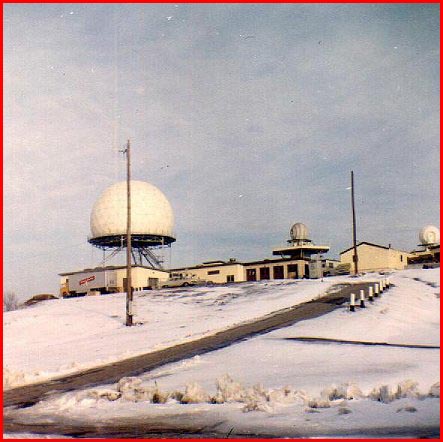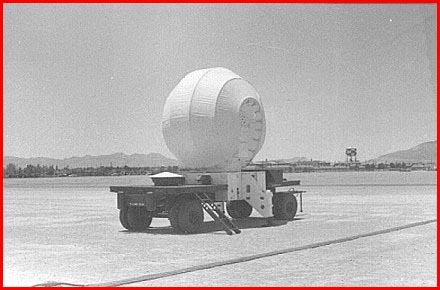For
more Information and pictures on SAGE click here

ca
1962
photo
by Ron Gelinas
In 1962 we completed upgrading from a regular Hercules Missile battery to the Improved Hercules System. This gave us much greater detection range and ECM capabilities and required us to retrain all the IFC personnel including me having to go back to Ft Bliss, TX for more schooling on maintaining the new system. We now had in addition to the Low Power Acquisition Radar (LOPAR) another larger High Power Acquisition Radar (HIPAR) antenna up on a 90 foot tower and a Target Ranging Radar (TRR) that helped us to track targets through more elaborate electronic jamming the enemy might throw at us. With this change also came four 20 foot short towers that all the other radars were mounted on. This envolved major construction on the hill for the five towers and more buildings including constructing a new larger Generator and Converter building for the higher AC power requirments of the new system. The generators inside were replaced with much larger Waukesha 6 cyl 1200 rpm diesels for emergency power backup when the commercial grid power coming into the Nike site failed. The HIPAR and FUIF room used 60 cycle power and the converters were used to convert the 60 cycle output from the generators to 400 cycle for use in the two radar vans. The other large building that was built was for the HIPAR transmitter and receiver equipment. The received target signal from this building was sent over to the Battery Control van for display on the Battery Commander's Plan Position Indicator (PPI) scope.
I came back in time from school at Ft Bliss to help install the new High Power Acquisition Radar (HIPAR) equipment in the new building on the hill and helped get it into operation. Never before had I seen radar tubes (or any tubes for that matter) quite so large! The main transmitting tube for the HIPAR was a long 10 Megawatt klystron that was ethelene glycol cooled and mounted vertically in an oil filled box for electrical insulation because the connections to the tube in that box ran in the order of 300,000 volts. The viewing glass window on the box was leaded glass to prevent dangerous X-rays from coming out and all the equipment cabinets had interlocks on the doors to prevent shocks that could prove fatal. The RF output ran thru a long wavequide out of the building and up inside the tower where it then was transmitted out the rotating antenna.
Even tho the tower was up 90 feet any one of us could stand on the ground on the hill and hold a fluorescent 40 watt bulb up in the air and it would light every time the antenna would swing aound. The high RF power the HIPAR transmitted also got into our first and only solid state computer called the FUIF. The FUIF room was not well RF isolated at all and and every time the antenna would swing around all the transistors would conduct. Martin company, the designers of the FUIF, spent several days RF isolating the room and finally the RF wasn't a problem any more.The HIPAR antenna was not much of a joy to work on in the winter. In Rhode Island sometimes we would get a fog which would freeze on the rungs of the different tower ladders and make climbing almost impossible until we finally had some heat tape installed. A safety belt connection going up that ladder was a MUST! Below is a picture of the HIPAR at Bristol in the winter looking from the bottom of the hill. Also you can see two of the other shorter towers with tracking radars on them.
Webmaster
Note:
FUIF is an acronym for
Fire Unit Integration Facility. It was a solid state computer at our location
that connected us by way of underground telephone cable to the SAGE system's
computer developed at MIT's Lincoln Laboratory in Massachusetts.
Mitre Corporation assumed the SAGE responsibility from MIT after it once
became operational. The FUIF's purpose was to take target Elevation, Azimuth
and Range digital data from the SAGE system and convert it to analog
data which we could use enabling our radars to acquire a target automatically
that was designated from the Direction Center at SAGE.
SAGE is an acronym for Semiautomatic Ground Environment System and was a digital Data Processing System for Air Defense. It's input data came from many different Early Warning sources on land, sea and air. Its output data was transmitted to weapons systems under its control such as Nike, to other SAGE systems around the country which numbered about 30 and to other government organizations that had a need to know such as Civil Defense.
For
more Information and pictures on SAGE click here

ca
1962
photo
by Ron Gelinas
Below is a picture of a Hercules tracking radar taken at Ft Bliss that could be either a Missile Tracking Radar, Target Tracking Radar or a Target Ranging Radar. They all looked alike from the outside but were very different inside the pressurized bubble. The radar was lifted off the wheeled trailer when it arrived at its location so the whole unit rested on the three leveling legs. These legs had to be checked periodically for absolute level of the antennas so range, azimuth and elevation information fed into the main computer was very accurate.

1960
Ft
Bliss photo
|
|
|
|